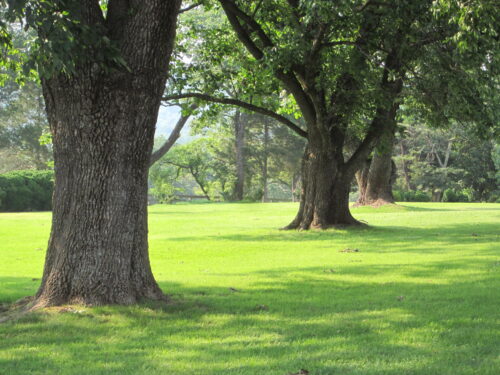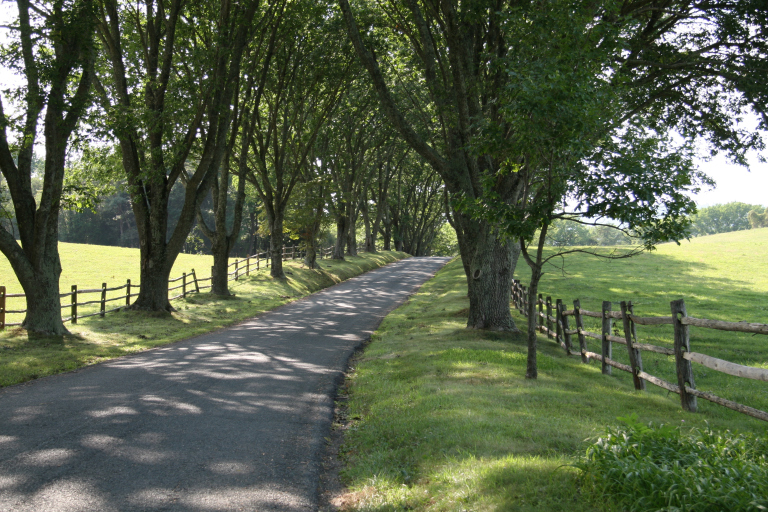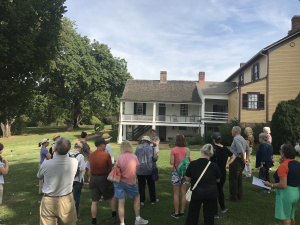Historical Landscape of James Monroe’s Highland
February 26, 2021 10:28 am

Property managers at James Monroe’s Highland recently conducted preservation work on the estate’s tree canopy using cost-share funding from the Virginia Department of Forestry (DOF). With more than 100 ash trees on the property, Highland has not been insulated from the effects of the emerald ash borer (EAB)– an invasive pest that damages and eventually kills native ash species. To maintain the overall health of their tree canopy, they’ve removed several ash trees that were infested with EAB, trimmed trees damaged by pests or storms, and began a cycle of EAB treatment on select individual trees.
You may know the property as Ash Lawn-Highland – President James Monroe’s estate in Albemarle County, Virginia The property was originally known simply as Highland, with the “Ash Lawn” descriptor as a more contemporary addition from a subsequent owner, likely in honor of the many beautiful ash tree specimens on the property. In recent years, the property’s name has returned to its historic roots.
Still, the ash trees on the property are no less iconic. The driveway leading up to the estate is flanked by rows of ash trees and frequently serves as a backdrop for photographers, particularly for wedding parties. The Peacock Yard, another frequently photographed site, also features stunning ash trees.

Many of the trees on the property are white ash and are likely 80-100 years old. While these trees don’t date back to the origins of the estate, they do contribute to the beauty and function of the property. Trees, of course, don’t live forever. As they age, they may become weak or susceptible to disease, damage, or pests.
The EAB infestation has been devastating to ash trees in many parts of the U.S., including Virginia. Treating healthy ash trees to prevent infestation is one option, but it can be costly. Cost-share programs like the one offered through DOF are one way that property managers can mitigate the costs associated with tree care.
Nancy Ocasio, Highland’s Business and Operations Manager, says that maintaining healthy trees on Highland is critical to preserving the overall aesthetic and use of the property, so treating the ash trees was ultimately a business decision – it may be costly, but they couldn’t afford the loss of the trees and their benefits.
But not all trees can be saved, and some may need to be removed for safety reasons – trees affected by EAB damage may become hazardous over time. DOF’s EAB cost-share program gives landowners funding to remove ash trees and replace them with other native species. Nancy says they’re considering American elm or hackberry as replacement options for the trees they’ve had to remove; these species can have a similar branching pattern that will visually match the remaining ash trees.
Broken or pruned limbs from trees on the property are given to local craftspeople who create functional works of art displayed and sold at Highland. Woodworkers have created items such as pens and bowls from ash wood. Other items may be crafted from trees on the property that are significantly older than the ash, including limbs from a white oak and a hemlock that are each more than 300 years old.

These historic trees demonstrate the property’s deep connection to our nation’s rich history. Nancy says that the estate is one of the most interesting places she could imagine working, in part because there’s always so much new to learn, even about events that happened long ago.
During Monroe’s time, and for several generations beyond, enslaved people lived on the Highland estate. The interpretive materials for Highland acknowledge the legacy of slavery inextricably tied to the property, the people who lived there, and the generations of descendants now dispersed throughout the country.
The Highland staff are collaborating with the Highland’s Council of Descendant Advisors to curate and reinterpret displays and exhibits on the estate that share a more comprehensive story. For example, while many displays in the Presidential Guest House have focused on the furniture, art, and use of different rooms, the updated displays will center more on sharing stories of the individuals associated with these spaces. The Highland webpage explaining the engagement with the Council states: “Our collaboration makes the stories more relevant to our community and more truthful.” [Read more about the Highland’s Council of Descendant Advisors.]
A rustic trail system weaves along the Highland property, installed by Boy Scout troops decades ago. Volunteers have performed extensive work and dedicated many hours to restoring the trail system. These trails, though not necessarily historic, allow visitors to appreciate and experience the property in a different way. Even the trails benefit from the full lifecycle of the removed ash trees on the property; when the cut trees are chipped, they are used for mulch along the paths.
Ultimately, giving ongoing care to the tree canopy at Highland bolsters the preservation of an historic space that holds the stories of many and diverse generations of Virginians.
Learn more about James Monroe’s Highland.
Featured Image: Ash in Peacock Yard. Photo Credit: James Monroe’s Highland
Tags: Ash, Emerald Ash Borer
Category: Financial Assistance, Urban and Community Forestry
